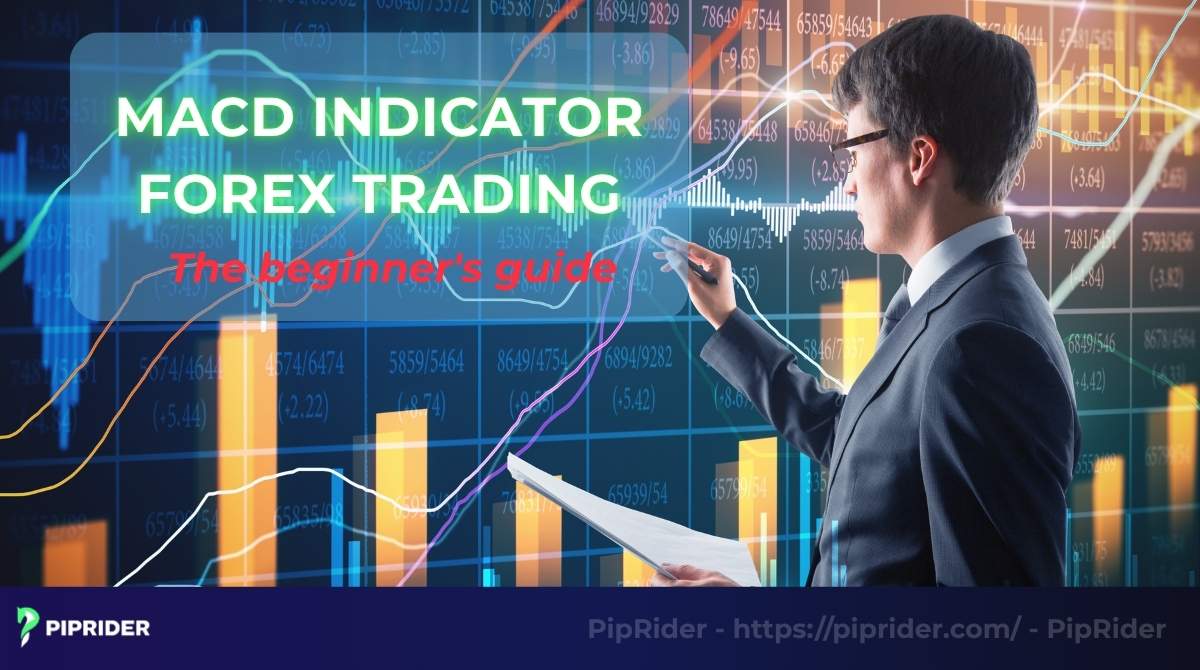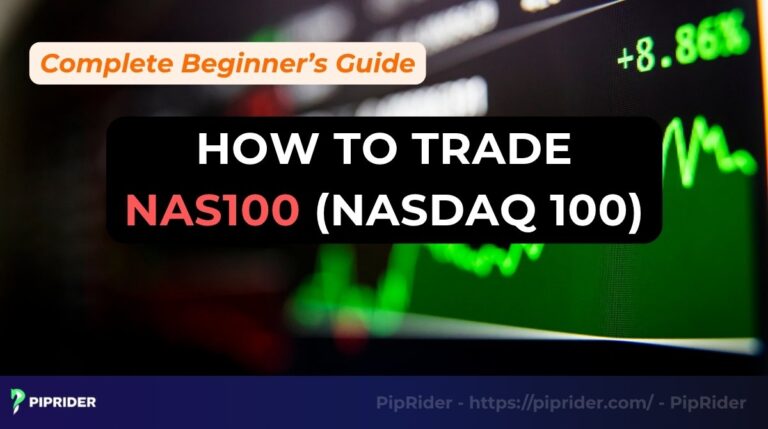Market volatility often disguises a lack of true momentum. The Moving Average Convergence Divergence (MACD) indicator is the powerful tool used to solve this problem. It acts as a speedometer for a trend, tracking the relationship between two moving averages to show strength and direction.
In this guide, Piprider will break down the MACD indicator forex trading in practical terms and instruct you on how to use its signals and avoid common mistakes to confidently time your entries and exits.
Key Takeaways
- The MACD is a momentum indicator that uses its three components to gauge a trend’s power and direction.
- Crossovers and divergence generate the powerful signals for the indicator
- A growing histogram indicates strengthening velocity, while a shrinking one shows its fading.
- For most traders, the standard 12-26-9 input is the most dependable starting point.
- It is a lagging confirmation tool and should never be used as the sole reason to enter a trade.
1. What is the MACD indicator?
The MACD (Moving Average Convergence Divergence) is a trend-following momentum indicator that primarily tracks the relationship between two moving averages.
According to Investopedia, the MACD indicator was developed by Gerald Appel in the late 1970s (Dolan, 2025). Its main job is to help traders gauge the market’s force, showing whether buying or selling pressure is getting stronger or weaker.
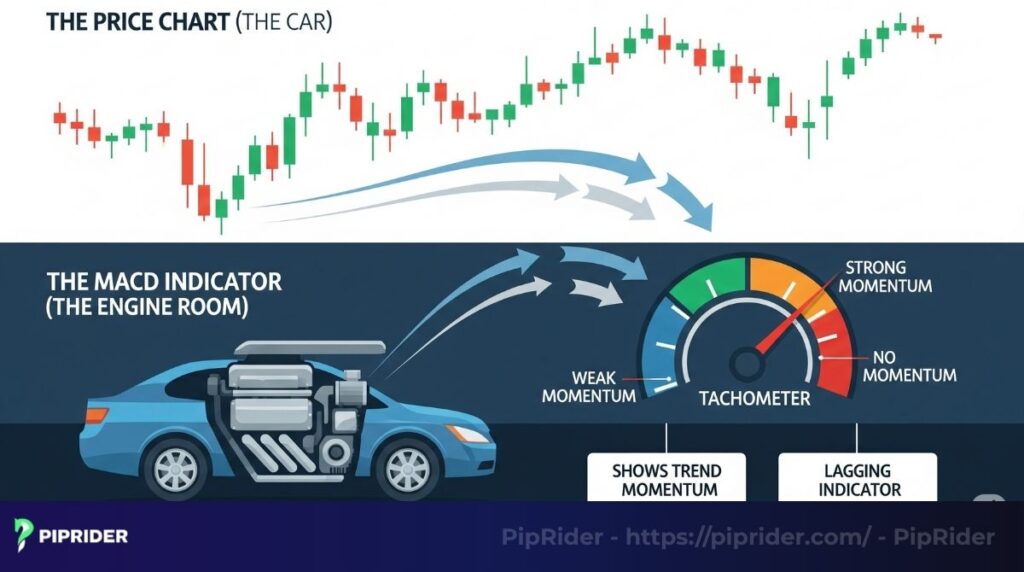
Similar to the engine room of a car, this indicator helps traders identify emerging trends, spot potential reversals, and find clearer entry and exit points. It works particularly well in strongly trending markets.
However, like all moving average-based tools, the MACD is a lagging indicator and should never be used alone. Think of it as the “engine room” of the price chart; it tells about the power, speed, and health of the trend, giving traders the information they need to make better trading decisions.
2. How does the MACD indicator forex trading works?
The MACD indicator is made of three simple components that work together. Understanding these three parts is key to understanding how the indicator works as a whole.
2.1. The structure of the MACD
Let’s break down each component without getting lost in complicated math.

The image show that there are three key elements:
- The MACD line, often referred to as the “engine”: is the faster of the two lines in the indicator. It is calculated by subtracting the 26-period Exponential Moving Average (EMA) from the 12-period EMA. This calculation creates the MACD line, which reflects short-term shifts in momentum (StockCharts, n.d.).
- The signal line (the “navigator”): Created by taking a 9-period EMA of the main MACD line, its averaging process naturally makes it move slower. Consider the smoother, more stable guide that helps confirm the signals given by the faster.
- The histogram (the “power gauge”): This is the trader’s favorite part because it’s so visual. Its bars visually represent the space between the MACD line and the signal line, giving an at-a-glance view of the trend’s velocity.
2.2. The meaning behind the movements
Now, let’s connect these parts to actual buy and sell signals.
- When the main MACD line crosses over the slower signal line, it creates a bullish signal. This tells traders that short-term momentum is now accelerating upwards faster than the recent average. The histogram will flip from negative to positive.
- When the MACD line crosses below the signal line, it’s a bearish signal, suggesting that the downward trend is now taking control.
- When the histogram gets:
- Taller, it means the gap between the two lines is widening, and the velocity of the current move is strengthening.
- Shorter and shrinking back toward the zero line, it’s a huge warning sign that the current trend is losing steam. This is often the earliest clue that a move is nearing exhaustion.
Read more:
How To Use Fibonacci Retracement In Forex Trading
3. How to apply the MACD indicator in forex trading
Understanding the theory is one thing, but reading the signals in a live market is what truly matters.
There are three primary signals:
3.1. How to read the MACD signals
Learning to interpret these signals correctly is the first step toward making the MACD a useful part of the toolkit. Let’s break down each one.
- The signal line is the classic buy/sell trigger, occurring when the faster MACD line crosses the slower Signal line. Crossing up signals momentum turning positive. However, this signal requires confirmation to avoid false signals.
- The zero line acts as a major filter, indicating a shift in medium-term sentiment. Crossing above zero confirms bullish control, while crossing below confirms bearish control.
- The histogram measures acceleration. Growing bars signal that current strength is increasing, while shrinking bars warn that the move is losing steam and nearing exhaustion.
3.2. Notes on using different timeframes
A common mistake is assuming the MACD behaves the same on all charts. It absolutely does not.
- On lower (like M15): The indicator will be extremely active, producing many crossovers. While this might seem great for scalping, most of these signals will be market noise. Traders avoid using it as a primary tool on charts this low.
- On medium (like H1): This is often the “sweet spot” for many day traders. The signals are frequent enough to provide opportunities but are generally more reliable and less prone to noise than on the M15 chart.
- On higher (like H4 and Daily): A signal here is a major event. A MACD crossover on a daily chart signifies a potentially significant and long-lasting shift in market power. Think of this as identifying the main ocean current, not just the small waves.
3.3. A pro tip: Combine MACD with price action
Don’t trade the indicator in a vacuum. Let the indicator’s signal serve as confirmation for what the price action is already suggesting. For instance, picture a scenario where the price retraces to a critical support level and a bullish pin bar appears. At that exact moment, see the MACD make a bullish.
That isn’t just a signal; that’s a high-probability A+ setup where both price and momentum are in perfect agreement. Adding a confirmation from rising trading volume would make this an even stronger setup.
4. Setting up and customizing the MACD on your charts
Getting the MACD onto the chart is simple, as it’s a standard, built-in indicator on virtually every trading platform. Let’s walk through the quick setup process for the two most popular ones: MT4 and TradingView.

4.1. Step-by-step guide
This simple process takes less than a minute on either platform, so let’s get it done.
- MetaTrader 4 (MT4): In the top menu, go to Insert -> Indicators -> Oscillators. From the list, simply select MACD. A settings window will pop up with the default parameters already entered. You can adjust colors here. Confirm by clicking ‘OK’, and you will see the indicator loaded in a new panel below the chart.
- TradingView: Select the ‘Indicators’ option from the main toolbar at the top of the chart. In the search bar, just type “MACD”. Select the indicator from the list, and it will be instantly applied to the chart. TradingView’s interface is very intuitive.
4.2. Should you use default or custom settings?
For most traders, particularly beginners, the default 12-26-9 settings are sufficient. These values are the standard across most charting platforms and have been used for decades. Because so many traders follow them, the signals carry extra weight and can sometimes be self-fulfilling (Dolan, 2025).
However, as traders become more experienced, they might want to experiment. Here are some common adjustments:
- For scalping (very short-term): Some scalpers might use faster settings like 5-10-5 to get quicker signals, but be warned: this will dramatically increase the amount of market noise and false signal.
- For swing trading (longer-term): To get a smoother, longer-term view of momentum, some traders double the standard settings to 24-52-18. This will give traders fewer but more significant signals.
4.3. Important notes when viewing the chart
There are two final things to burn into the memory when using this indicator.
- Understand its inherent lag: The MACD is, by its nature, a lagging indicator. It is always telling about the velocity of the recent past. It is a confirmation tool, not a predictive one. Never forget this.
- Respect the timeframe: A MACD signal on a weekly chart is infinitely more powerful than a signal on a 5-minute chart. Traders should always place more importance on signals that appear on higher timeframes.
5. Forex trading strategies with the MACD for beginners
An indicator is useless without a trading strategy, a set of rules that tells exactly when to enter, where to place the stop loss, and when to take profit.
Piprider are going to share two powerful yet simple strategies. Traders can practice these extensively in a demo account until they become second nature.
5.1. Strategy 1: The trend-filtered MACD crossover
The trend-filtered MACD crossover is probably the most reliable MACD strategy for beginners because it’s designed to keep traders on the right side of the main market trend.
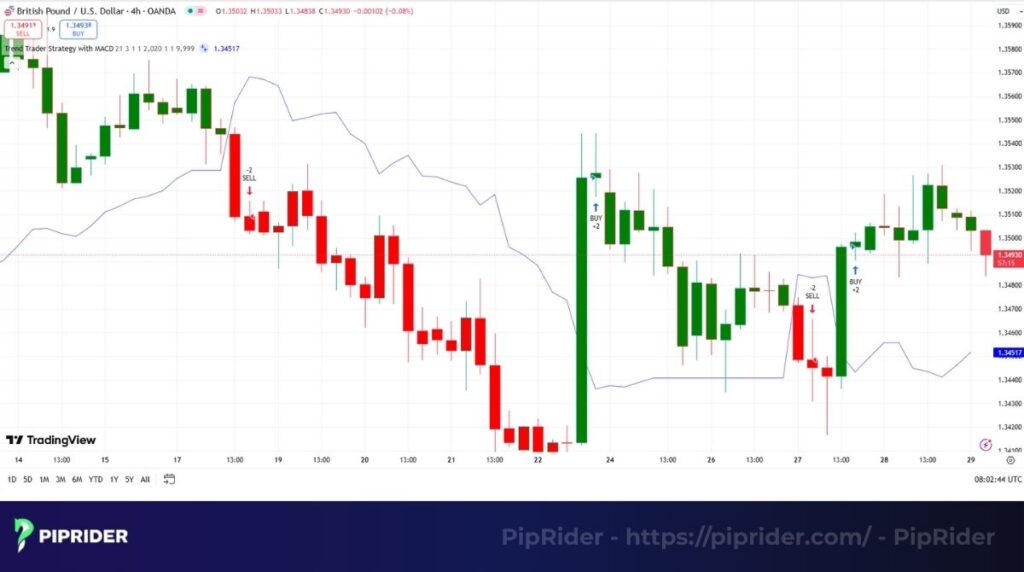
A longer-term moving average, like the 50 EMA, is used as a “trend filter” or “boss.” Exponential moving averages are preferred in this role, as they react faster to recent price changes. If the price is above the 50 EMA, search exclusively for buy signals. If it’s below, only sell signals should be sought, waiting for a bearish confirmation.
The rules for a buy trade:
- To confirm a trend, price must be trading above a 50-period moving average that is sloping upwards. This is a non-negotiable rule.
- One should look for when the MACD line makes a clear cross above its signal line. This must happen while the price remains on the correct side of the 50-period average.
- Enter a buy order at the opening of the next candle after the crossover is confirmed.
- The stop loss should be placed just under the most recent swing low.
- Target a key resistance level or aim for a fixed risk-to-reward ratio, such as 1:2.
5.2. Strategy 2: MACD divergence with support and resistance
The MACD divergence is a more advanced reversal strategy, but it can be incredibly powerful for catching the end of a trend.

Divergence is a powerful warning sign that momentum is fading. A key support or resistance level is a well-known “battleground” where the price has previously changed direction. When these two events happen at the same time, it creates a very high-probability reversal setup.
The rules for a buy trade:
- Identify a key area: First, find a strong, pre-existing support zone on the chart.
- Spot the divergence: As price approaches to test this zone, observe for a new lower low on the chart, while the MACD histogram forms a higher low.
- Entry: Wait for a confirmation, such as specific candlestick patterns. Enter after that candle closes.
- Stop loss: Place the stop loss just under the lowest point of the confirmation candle. If the price breaks this point, the trade idea is invalid.
- Take profit: Target the nearest significant resistance point
5.3. A quick tip for practice and backtesting
Do not trade these strategies with real money until you have tested them. Use the “Bar Replay” function on TradingView to go back in time and trade the setups as if they were live. Be honest with the results. This is the only way to build true, unshakable confidence in a system.
6. MACD vs. RSI: Which one to use and when?
As trades explore technical analysis, they’ll see both MACD and RSI mentioned constantly. Since they are both momentum indicators, many beginners ask, “Which one is better?”
A more useful question is, “What tool is right for the specific task a trader needs to accomplish right now?”
6.1. Head-to-head comparison: MACD vs. RSI (Relative Strength Index)
To make it simple, let’s break down their key differences in a table.
| Feature | MACD | RSI |
| What it measures | The relationship between two exponential moving averages (trend & momentum). | The speed and change of price (overbought/oversold). |
| Primary signals | Crossovers of its lines and changes in its histogram. | Reaching extreme levels (above 70 or below 30). |
| Responsiveness | Slower, as it’s based on moving averages. | Faster, making it more sensitive to recent price changes. |
| Best for | Assessing the power and direction of an emerging or ongoing trend. | Identifying possible short-term reversal points within a sideways market. |
6.2. When you should use them together
Instead of choosing one or the other, the best approach is often to use them as a team to confirm each other’s signals.
Here is a common framework:
- Use the RSI for initial signals. The RSI is faster and will often be the first to show traders a potential opportunity. For instance, it might drop into the oversold area (below 30) as the price nears a critical zone. This is the initial “heads up”.
- Use the MACD for final confirmation. Once the RSI provides its initial cue, then await a concurring signal from the MACD. For instance, after the RSI moves below 30, traders would wait for the MACD to have a bullish crossover. This second layer of confirmation helps filter out many of the false signals that RSI might give on its own.
7. Common mistakes when using the MACD (and how to fix them)
Learning the MACD signals is the easy part. The hard part, where most new traders lose money, is learning to avoid the common traps. There are three common mistakes that almost all traders can make.
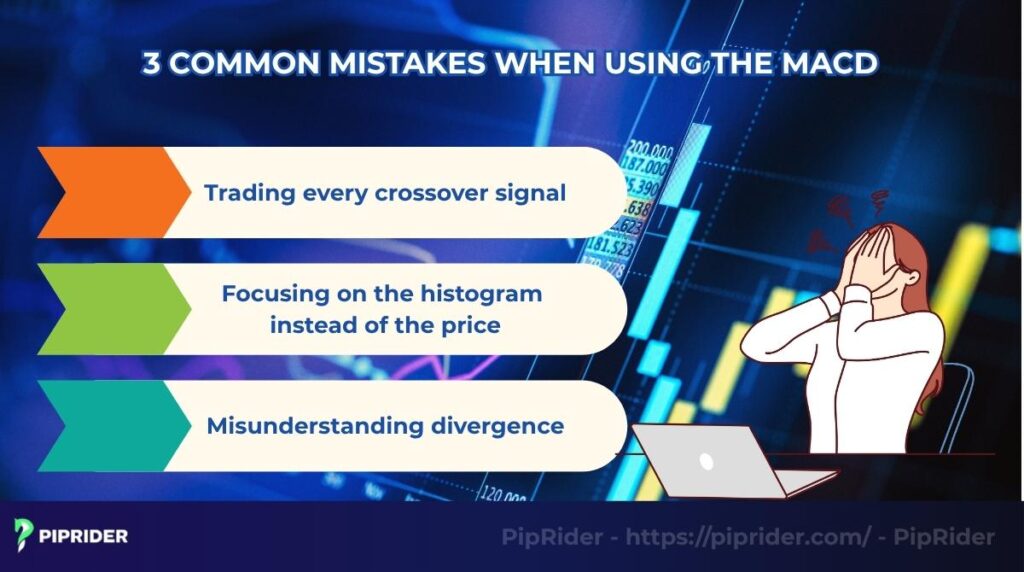
7.1. Mistake 1: Trading every crossover signal
A trader sees the MACD line cross the signal line, they immediately jump into a trade, and then wonder why they keep getting stopped out.
- The reality: In a choppy or sideways market, the MACD will produce dozens of crossover signals, and most of them will be meaningless noise. These are low-probability signals.
- The solution: Always combine this signal with a trend filter. A simple rule like “Only take MACD crossovers that happen above the 50 EMA” will instantly filter out the majority of bad trades.
7.2. Mistake 2: Focusing on the histogram Instead of the price
A trader becomes so focused on the histogram bars growing or shrinking that they completely miss what the price candles are telling them.
- The reality: The histogram is a calculation based on another calculation, putting it several steps away from the actual price.
- The solution: Wait for a clear signal like a bullish pin bar, then look at the histogram to confirm if velocity is increasing.
7.3. Mistake 3: Misunderstanding divergence
Divergence is a powerful concept, but it’s also widely misunderstood. Many traders see a tiny bit of this condition and immediately enter a trade, expecting a massive trend reversal.
- The reality: It is a signal that momentum is fading, not a guarantee that the trend will reverse immediately. A trend can continue for a long time with weakening velocity before it finally turns.
- The solution: Never trade this signal alone. Wait for it to be confirmed by a clear break of a trendline or a shift in market structure (like a lower high in an uptrend).
In short, the solution to almost every mistake is to stop treating the indicator like a magic standalone system. This indicator works best as part of a team, combined with trend analysis (like an EMA). And remember, avoid using MACD in a strong sideways market; it is a trend-following one and will give traders endless false signals when there is no trend to follow.
8. FAQs
Here are some quick answers to the most common questions:
9. Conclusion
After all this analysis, we reach the final verdict: the MACD indicator forex trading absolutely deserves a place in your forex trading toolkit. While it is not a magic wand and can sometimes lag, its true strength lies in its ability to validate a trend’s health and warn when momentum is fading.
The path forward is simple: first, get the MACD on your charts and start practicing with simple strategies on a demo account. Once you are comfortable, the next step is to learn how to combine it with other tools, such as the RSI and various EMAs, as they are its most powerful partners.
Always remember the key advice: “It’s far better to master one simple indicator than to be confused by ten complex ones.” To discover more powerful tools and trading strategies for forex trading, we encourage you to follow us at Piprider and explore our in-depth guides.


